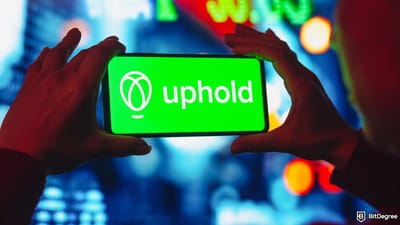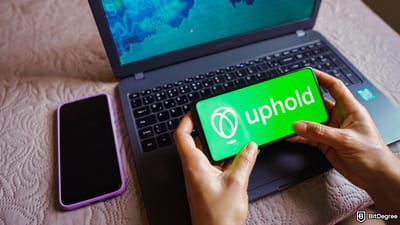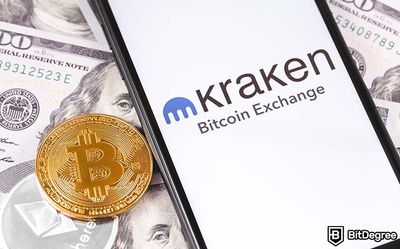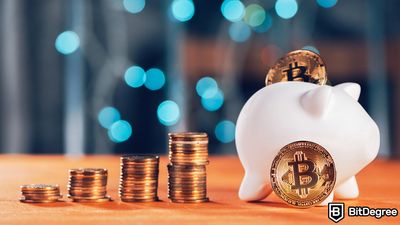Ace quick missions & earn crypto rewards while gaining real-world Web3 skills. Participate Now! 🔥
Since Bitcoin was created in 2009, the world has gone crazy for cryptocurrencies. In fact, there are now more than 1,500 different coins available to buy, sell and trade! However, the most important thing to come from all of this so far is the technology that underlies it — blockchain technology. So, what is blockchain?
If you would like to find out what is blockchain in a simplified format, you’ve come to the right place! Although the technology is quite complex, I am going to use real-world examples and as simple vocabulary as possible so that you understand it from top to bottom!
My “What is blockchain tutorial” is going to start by explaining what the technology does and how it works, followed by a discussion on its advantages over traditional systems. I am also going to give you some examples of how it can be used (and is being used) in everyday life.
So what are you waiting for, let’s begin by understanding what blockchain technology actually is!

Did you know?
Subscribe - We publish new crypto explainer videos every week!
NEAR Protocol Explained: Beginner's Guide to NEAR (Animated)


Table of Contents
- 1. What is Blockchain Technology?
- 2. Blockchain Definition: Why is it Called Blockchain?
- 3. How are Transactions Confirmed on the Blockchain?
- 4. The Importance of Decentralization
- 5. How Anonymous is the Blockchain?
- 6. How Can Blockchain Be Used in the Real World?
- 6.1. Cross-Border Payments
- 6.2. Elections
- 6.3. Supply Chain
- 6.4. Gambling
- 6.5. Insurance
- 7. What is Blockchain? - Conclusion
What is Blockchain Technology?
In its simplest form, the blockchain is the technology that allows people to send and receive cryptocurrencies such as Bitcoin. However, it is far more than just a payments system. When Satoshi Nakamoto created the world’s first ever cryptocurrency (Bitcoin), he also created an amazing protocol known as the blockchain.
Latest Deal Active Right Now:Score up to $200 in BTC or USD – just sign up and make your first crypto purchase to get a go at the Reward Wheel. Instant spin. Instant reward. Follow this Coinbase referral link to activate the deal!
The most interesting part to the blockchain is that no single person or authority has control over it. Instead, transactions are verified and confirmed by the online community, which makes it decentralized! The protocol has lots and lots of benefits such as transparency, speed and security, which I will explain in more detail later on.
The actual idea of blockchain technology is not only linked to financial transactions, as it has the potential to be applied to just about any industry!
As the blockchain is decentralized, everybody has access to the same data (unless it is a private blockchain used by companies). That means that as soon as a transaction is processed and confirmed, it appears on the blockchain for all to see.
This is very similar to a real-world accounting ledger, where the company accountant can view every transaction that has ever occurred, along with account balances. However, as blockchains such as Bitcoin and Ethereum are public, anyone can view the transactional data.
There is so much to talk about when trying to understand the correct blockchain definition, so I thought it would be best to break everything down. The next part of my “What is Blockchain” guide is going to talk about why it is called blockchain!
Blockchain Definition: Why is it Called Blockchain?
Although there are now many different versions of the blockchain definition, they all work in very similar ways. The easiest way to explain what it does is to split the word blockchain into two – block and chain!
Think about a real-world container that carries lots of boxes from destination A to destination B. In the world of cryptocurrency, the container is the “block” and each box that is on the container is an individual transaction.
“Container” = Block
“Boxes” = Transactions
“The container carries lots of boxes” = The Block Carries Lots of Transactions
I know this might sound complex, but stay with me as it is all about to make sense! So, in the example of the blockchain Bitcoin uses, it takes a total of 10 minutes for one block of transactions to be confirmed on the network.
Like in a real-world container, there is only a certain amount of transactions that the block can carry, which is determined by the maximum block size. Every blockchain has its own maximum block size, which is normally the amount of data (megabytes) it can hold.
Bitcoin is able to hold the 1MB worth of data in each block, while others, such as Bitcoin Cash, have a block size limit of 8MB.
The larger the block size limit, the more transactions it can hold. So now you know what a block is, what about the chain?
To make things really easy for you, I am going to stick with the example of a container carrying boxes! Let’s imagine that the container has reached its first destination. That means the block has been confirmed and it is now available on the public ledger for all to see.
However, the container is ready to depart for its next destination. Every new or old box (transactions) that the container (block) carries will also be available to view on the public blockchain. This is the same for every single transaction. As soon as it is confirmed, the transaction data is clear for everybody to see, which is why it is called a “chain” of transactions!
So now that you understand where the blockchain definition comes from, the next part of my “What is blockchain” guide is to explain how transactions are confirmed!
How are Transactions Confirmed on the Blockchain?
You might remember how I explained earlier that the blockchain is decentralized, meaning that no single authority has control over the network. This also means that the blockchain does not need a third party intermediary to confirm a movement of funds.
If that’s the case, how are transactions confirmed? This is where things get really interesting!
The blockchain is a community-based platform, meaning that in most cases, anybody can contribute to the network to help verify transactions. They do so by contributing their computational power, which in return, is able to support the network.
Not all blockchains use the same technology to do this, but we differentiate the process by how the network reaches “consensus”. Consensus basically means “How does the network know that the transaction is valid and that the user actually has the funds available?”
Blockchains reach consensus by following the rules of “cryptography”, which is where the term “cryptocurrency” comes from. Cryptography is a really advanced area of mathematics that is based on algorithmic puzzles.
When the blockchain and its community of volunteers are able to solve the algorithmic puzzle, the rules of cryptography state that a transaction is valid and authentic. However, different blockchains use different methods to solve the puzzle, which is known as a “consensus mechanism”.
Confused? Don’t be, as my “What is blockchain” guide is now going to give you an example!
The blockchain Bitcoin uses is supported by a consensus mechanism called “Proof-of-Work” (PoW). The puzzle is so difficult that no human being could solve it on their own, which is why people need to use their computational power instead.
Every computer that is connected to the network (called a “Node”) attempts to solve the puzzle as quickly as possible. Whoever solves the puzzle first, gets a reward – free, new Bitcoin. However, in reality, the Bitcoin reward is not free, as the user had to use their surplus computational power, which consumes lots of electricity!
PoW is just one example of how a blockchain reaches consensus. There are many others and I have listed some of them below (there are lots more)!
- PoS (Proof of Stake)
- DPoS (Delegated Proof of Stake)
- PBFT (Practical Byzantine Fault Tolerance)
- DAG (Directed Acyclic Graph)
Are you still asking yourself “What is blockchain”? I hope not! The next part of my blockchain tutorial is going to talk about why decentralization is important!
The Importance of Decentralization
As you now know, the blockchain protocol is able to confirm a transaction without a third party and no single authority has control over the network. This is why it is decentralized. But why is this important?
Firstly, decentralization is very secure. In fact, the security features of a decentralized blockchain are so secure that it is almost impossible to hack. Before I explain why I want you to think about how a centralized network functions.
Let’s take a look at an organization like Yahoo. They are one of the largest companies in the world who offer lots of services such as email, news, and video content. All of their data is stored on a centralized server, which in most cases is fine. But what happens if the centralized server fails?
This is exactly what happened in 2016 when a group of hackers managed to gain control of the Yahoo servers, which then allowed them to access more than 3 billion private email accounts.
This isn’t a one-time incident either. Whether its social media, banks, internet service providers or the U.S. election, centralized servers are hacked all the time. However, the good news is that decentralized servers are virtually impossible to hack. Here’s why!
Do you remember how my “What is Blockchain” guide explained that to confirm a transaction, lots and lots of people contribute their computational power? These “Nodes” not only help verify a movement of funds, but they also keep the network secure. This is because more than half of the nodes on the entire network would need to be hacked at the same time for something bad to happen!
Even if this was possible (which it isn’t, really), the hacker would only be able to make changes to the blockchain for 1 block, which in the case of Bitcoin, would be about 10 minutes!
Decentralization isn’t only important for security, but for equality, too. Everyone who engages with the blockchain has the ability to contribute to the system. Furthermore, as each and every transaction is available to view on the public ledger, it makes the network transparent. No corruption, no fraud, and no inequality!
Now that you know why decentralization is important, the next part of my What is Blockchain tutorial is going to look at how anonymous the blockchain is!
How Anonymous is the Blockchain?
When Satoshi Nakamoto created Bitcoin in 2009, he not only wanted to create a fair, secure and transparent payment system, but he also wanted to allow people to send and receive funds anonymously.
Think about how you spend your money in everyday life. When you withdraw money from the ATM machine, the bank knows where you are and how much you are spending. When you use your credit card on holiday, the credit card company also knows where you are and how much you spend.
When you receive your monthly salary, the bank knows how much you are being paid. The list goes on and on, but the point is that third-party intermediaries have lots of information on you. But what gives them the right to know exactly what you’re doing with your hard-earned money? Nothing does! They shouldn’t know.
This is where blockchain technology is different. When you obtain a cryptocurrency, you store it in a digital wallet. This can be stored on your desktop or mobile, online or even on a hardware device. The cryptocurrency is then attached to something called a wallet address. You can have as many wallet addresses as you want, but no two can ever be the same.
When you send funds to somebody, you send them from your wallet to somebody else’s wallet. Here is what a blockchain Bitcoin transaction would look like.
Wallet “1BoatSLRHtKNngkdXEeobR76b53LETtpyT”
Sent “2 BTC” to
Wallet “1CfaunqrVpcXmpLheUVWeSP1KPsKDha1Nb”
On Friday 18th May 2018 at 15.37.
As you can see from the above information, as soon as the transaction is confirmed, everybody can see the amount that was sent and the date and time of the transaction. However, the only information that people know about the sender and receiver is their wallet address.
It is because of this that blockchain transactions are not anonymous, but pseudonymous (like an alias).
However, this is just like spending cash in the physical world. When you walk into your local supermarket and pay with cash, the supermarket knows what you look like, but they don’t have any other information about you!
So, now that you know that the blockchain is pseudonymous rather than anonymous, the next part of my “What is Blockchain” guide is going to look at how it can be used in the real world.
How Can Blockchain Be Used in the Real World?
In reality, blockchain technology could be used in practically every industry or sector. By replacing centralized servers with that of a decentralized blockchain, individuals, companies and even governments could benefit from all of the advantages that the blockchain offers, such as security, transparency, and speed!
I am afraid I can’t go through every single industry that the blockchain could be used for, so I will list five of my favorites!
Cross-Border Payments
The cross-border payments industry is a multi-trillion dollar business, with banks needing to send international payments on a daily basis. The majority of this is handled by a third party called SWIFT, who are based in Belgium. SWIFT were set up in the early 1970s to make international payments easier, however the system is slow, expensive and inefficient.
This is because banks are not able to transact with each other directly. Instead, they have to use SWIFT and in some cases, additional correspondent banks. However, by using blockchain technology, banks would be able to do business on a peer-to-peer basis.
This means that there is no third-party intermediary sitting in between the two organizations. Transactions would no longer take days, nor would they cost lots of money! The Ripple blockchain was designed exactly for this purpose and they already have more than 100 different banks testing out their protocol!
Elections
How many times do we hear about election fraud? Whether it is the centralized network of the U.S. election being hacked (allegedly!) or governments who threaten their citizens with violence if they don’t vote for them? Unfortunately, this happens all the time, but blockchain technology could solve the problem!
Firstly, as every single transaction that has ever occurred is available to view on the public ledger, it would be impossible for a political party to change or remove votes. Remember, the blockchain is not only for financial transactions, as it can process anything that is considered data!
The blockchain would also be perfect for elections as transactions are pseudonymous, meaning that nobody would know the real-world identity of the voter. Instead, a citizen’s identity could be linked to a private key that only the individual user has access to. This would ensure that the citizen can only vote once!
Supply Chain
A supply chain is how goods move from their point of origin to their final destination. An example of this is an orange juice drink. The supply chain starts at the location where the orange was grown, it might travel to a factory to be turned into juice, then it might travel to the warehouse, and finally, to the supermarket.
At the moment, it is very difficult to trace each individual stage of the journey, as each part of the supply chain uses its own centralized systems. However, by using blockchain technology, the entire supply chain process could be available for all to see.
This would be a lot more efficient, transparent and secure than using centralized servers, as everything could be put on to the same network. Furthermore, the network would never go down and it is fraudproof!
Gambling
The online gambling industry is worth billions of dollars each and every year. Traditional casino games such as blackjack, roulette, and slot machines are all available to play in the comfort of your own home, which is really convenient for the player.
However, as online casinos normally keep their gameplay data behind closed doors on their centralized server, there is never any guarantee that the casino is truly playing fair.
By using blockchain technology, gaming outcomes can be independently verified on the public ledger, meaning that the system and data would be completely transparent. This could also be used for national lotteries, too!

Did you know?
Subscribe - We publish new crypto explainer videos every week!
Sidechains in Crypto Explained EASILY (Animated)



- Secure and reliable
- Accepts fiat currencies
- Lots of trading options
- Reputable exchange
- Accepts fiat currencies
- Offers various trading options

- Accepts fiat currencies
- Simple to use
- Supports only trusted cryptocurrencies
- A leading cryptocurrency exchange platform
- Best for all type investors
- Accepts fiat currencies

- Beginner-friendly
- Secure
- Decent trading and withdrawal fees
- Crypto.com Visa Card
- Automated tools & bots
- Ecosystem synergy with CRO
Insurance
The insurance industry covers practically everything on Planet Earth. Whether it’s your home, car, pet, health, holiday or phone — if it has value, it can be insured!
The problem is that the industry is dominated by third-party intermediaries, which means that taking out a policy is expensive and when it comes to making a claim, it’s a very slow process. However, the blockchain protocol would allow somebody to get insured without needing a third party.
For example, if somebody wanted to ensure their flight, as soon as the plane actually takes off, the outcome could be settled automatically. Either the plane takes off on time and you lose your insurance payment, or the plane is late and you receive a payout!
This could all be done in a transparent, fast and secure eco-system, such as the blockchain!
What is Blockchain? - Conclusion
That’s the end of my “What is Blockchain” guide! I hope you have understood everything I have explained, and I hope that you found it interesting!
I know the concept sounds really complex at first, but I am hoping that the real-world examples I have made things simple for you!
So, if you read my blockchain tutorial from start to finish, you should now know what the blockchain is and how it works. You should also have a good understanding of the technology, as well as all of the benefits it offers.
What is your favorite thing about the blockchain? I think it’s amazing how nobody controls it and that instead, control is distributed across the online community!
I have also spoken about five key industries that would benefit from blockchain technology. Do you agree with me, or can you think of some better ones? Whatever your opinion is, let me know in the comments section below! I just hope you aren’t still wondering what is blockchain!
Also, if you have any further questions, please ask us! We’d be glad to help.
Bonus: Test yourself on your new knowledge. See if you can answer the question of what is blockchain in an extremely brief format (less than 100 words). It's tough, but the shorter you can make a brief explanation, the easier it normally is to grasp the core principle of something!
The content published on this website is not aimed to give any kind of financial, investment, trading, or any other form of advice. BitDegree.org does not endorse or suggest you to buy, sell or hold any kind of cryptocurrency. Before making financial investment decisions, do consult your financial advisor.












